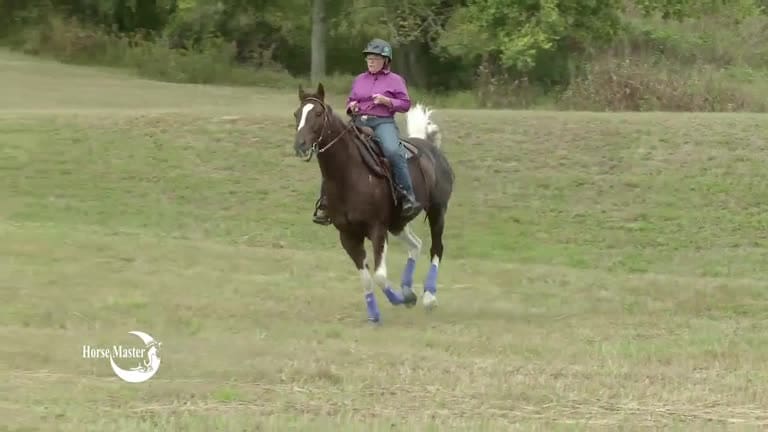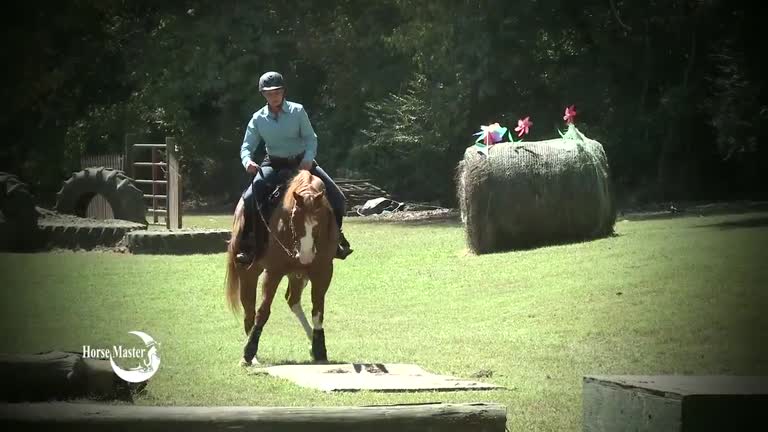Question Category: Issues from the Saddle
Question: Hello, I am have a Tennessee walker and she rides around the arena fine until she passes the gate. Then it happens, she starts to walk sideways in to the gate. I am a new rider so I’m not sure what to do. When I try to correct her she thinks I’m telling her to stop. How do I do it?
Answer: Your horse is simply gate sour and wants to stop at the gate and go out of it and back to the barn. All horses have this tendency, if not handled correctly, and it is sometimes known as “gate gravity.” This is an indication that your horse is disobedient and does not respect you as his leader or respect your authority over her. When you try to correct her with your hands, you are probably pulling on both reins, which means stop, and that is exactly what she wants to do anyway. In England your horse would be referred to as a “nappy” horse, which is a horse that refuses to respond to properly applied aids, particularly as it relates to leaving the barnyard. There are many ways to combat this problem.
First, you need to have a better understanding of horse behavior and the whole leader-follower/ dominant-subordinate part of horse life. You can get all the information you need on this from the articles and Q&As on my website.
Then you need to learn to do groundwork with your horse so that she respects your authority, looks to you as her leader and is obedient. There are numerous articles and Q&As on my website about this but you will probably need help from a qualified coach to execute the groundwork correctly. The articles will give you a better understanding of the principles behind groundwork, but reading is never enough. You’ll need some coaching as well to make sure you are doing it correctly. Groundwork done poorly can make a horse irritated, defensive and even aggressive.
Secondly, when you ride any horse, it is important that you choose the path that he walks on at all times. If he is making decisions on his own at any time about where he goes or how fast he gets there, then he will become disobedient. I see people eroding their authority with the horse all the time with little things like letting the horse walk off without being cued to walk or letting the horse come off the rail a step or two when riding in the arena or letting him cut the corners, slow down/speed up or walk off when you mount.
Every time a horse gets away with something like that he has scored a point of dominance over you. Typically before the rider realizes that she has a control problem, the score is already 250 to nothing and now she has a lot of catching up to do. Being persistent and particular in the beginning with a horse and insisting that he walk exactly where you say (not approximately) will put him in line in such a way that he wouldn’t think of varying from the path.
But to do that, you need to ride correctly and give clear, consistent and meaningful signals to the horse; not signals that are conflicting with each other, like pulling on both reins when you want the horse to turn or pulling back on the reins when you want the horse to go. My audios and videos explain how this is done, but again, you’ll probably need some good personal instruction too.
You need to learn to correct the horse with one rein, not two and by lifting up or sideways with the rein, not back. Pulling back on the rein, whether it is one rein or two, always opposes a horse’s forward motion and makes him want to stop (which is what he would prefer to do at the gate). Lifting your hand up or to the side will give you turning control without opposing his forward motion. You will also use your legs at the same time to both push the horse back into a straight line and keep him moving forward (the horse should move away from your leg- left leg makes the horse move right- both legs together makes the horse move forward). There are lots of articles on my website about using your aids properly, just make sure you are not pulling on both reins at the same time.
When a horse is moving out of the designated track you put him on, often just a lift up toward his ears with the outside rein is enough to block the horse’s movement in that direction. Which is the outside rein can become a little confusing at this point. Remember, the term outside or inside has nothing to do with the arena fence and has solely to do with the horse’s arc or bend. In your case, if the horse is pulling toward the gate, his nose is probably pointed toward the middle of the arena and his body is pulling toward the gate, so the outside rein is the one closest to the rail. If the horse were coming off the rail toward the middle, his nose is probably pointed toward the rail and his body is coming in toward the middle so the outside rein would be the one closest to the middle. Clear as mud, right?
Finally, make sure that you have good arena training practices. NEVER stop a horse at the gate. Never dismount at the gate and leave the arena; never ride your horse out of the arena. I always dismount far away from the gate and lead the horse out of the arena, so as not to make him focused on the gate. Furthermore, you may even want to ask the horse to work hard at the gate (ask him to trot every time he approaches the gate) so that he associates the gate with not such a great place to be. Similarly, if you ask a horse to circle and change directions every time he comes off the rail, he will eventually learn that the rail is not such a bad place to be because he doesn’t have to work as hard.
Remember, learning to ride and handle horses competently is a life-long pursuit. Every month you’ll be better and better, especially if you have some competent coaching along the way. Good luck to you!
Julie Goodnight
Copyright ©Julie Goodnight 2000. All Rights Reserved. No part of this website may be reproduced without owner’s express consent.



